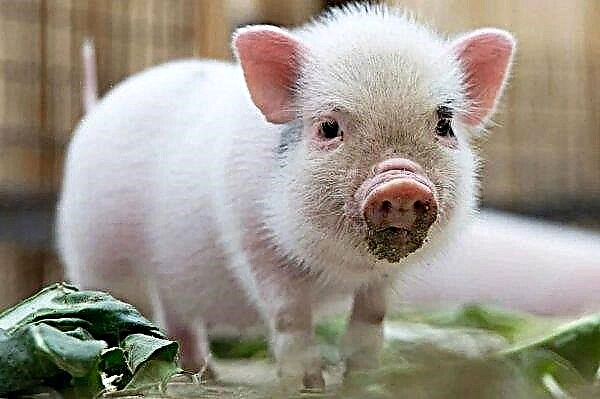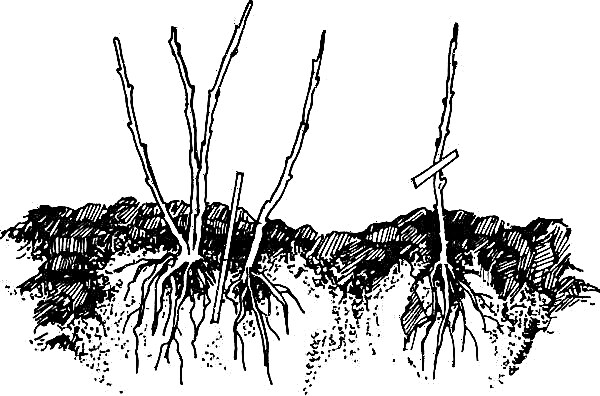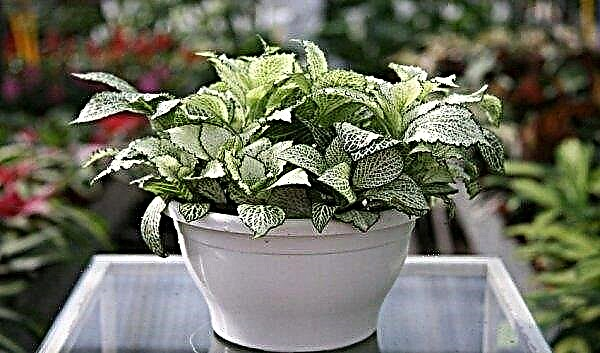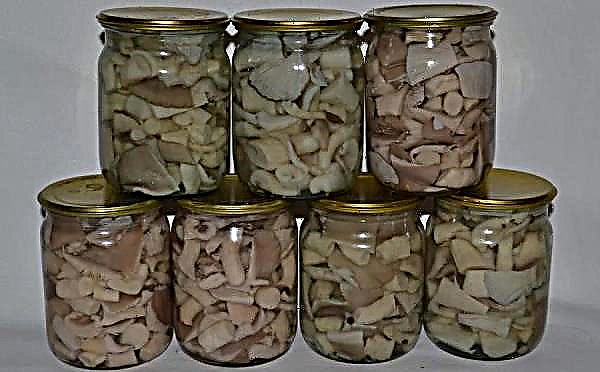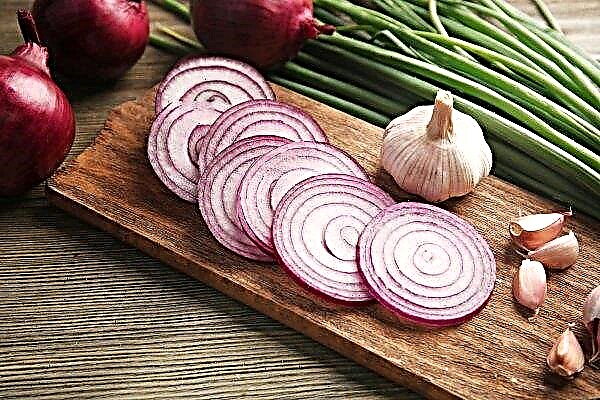Despite the fact that now on the shelves you can see green lentils, they buy it infrequently, since it is not a traditional food for us. Many simply do not understand what needs to be done with it and what dishes from it can be prepared. Our material will help you learn more about this valuable and tasty product and how to use it.
Description and characteristic
Lentils are small seeds of one of the varieties of the same name herbaceous plant of the legume family 30–50 cm high.
Flowering begins on the lowest branches, gradually moving up the plant, and continues until harvest. In place of the flowers, fruit beans are formed containing 1-3 seeds, the size of which is usually 4.5-8 mm in diameter. The weight of 1000 seeds is an average of 50–75 g.

The seeds are mainly composed of 2 halved husked halves. Both seeds have a shape similar to a biconvex lens, so in Latin they are called Lens culinaris.
These legumes are considered one of the oldest food crops. - It was grown in South-West Asia as early as 7000 BC. e. In West Asia and India, where many people are vegetarians, it has become the cheapest source of protein to meet its nutritional needs.
Did you know? Lentils are mentioned several times in the Bible: for example, the book of Genesis tells the story of Esau, who abandoned his birthright for a bowl of lentils and a loaf of bread.
Green lentils, also known as "large" or "Chilean", have a delicate aroma and nutty taste, do not require soaking and maintain their hardness and shape when cooking, which makes it an ideal component for salads or pilaf.
French green lentils (or puy), which is grown in the French region of Le Puy, smaller and darker than ordinary green, has the best texture and taste from all types of lentils and belongs to expensive varieties. Its seeds look gray-green and slightly mottled on the surface. This variety remains solid and requires an increase in cooking time up to 40 minutes.
 Most global lentil production is in Canada, India and Turkey.
Most global lentil production is in Canada, India and Turkey.
Growing technology
Although lentils have been an important crop for centuries, its selection and genetic research have a relatively short history compared to many other plants.
The technology for growing these legumes consists of the following activities:
- Field selection - soil structure and drainage are important for increasing yields. Increased soil moisture can lead to root rot.
- Sowing dates - the culture requires early dates, as it has a late ripening period (115 days). It is resistant to frost, drought, wind erosion and grows again, even if the aboveground part is damaged by frost to –6 ° C. Seeds are sown until the 3rd week of May. Drought and prolonged hot weather can lead to lower yields due to cracking of the pod.
- Seeding rate depends on the size and germination of seeds and is 100-140 plants per 1 m². Depth of incorporation is 3-5 cm into moist soil. A higher sowing density is recommended for arid areas and regions with a short season, as well as for germination of less than 80%.
- Weed control very important because this crop does not compete well with weeds.
- Fertilizers - during the growth process, plants need phosphates and nitrogen. Timely application of fertilizing (diammonium phosphate 50-60 kg / ha) will increase productivity.
- Diseases and Pests - if necessary, the fields are treated with insecticides and fungicides until the bushes close.
- Harvesting start in mid-August, when the lower beans become light brown in color, and when shaken, the seeds make a rumble inside the bean. Seed moisture should be 14%. Ripening is uneven.

Calorie cooked lentils per 100 grams
Calorie content of the product is 116 kcal.
BJU ratio:
- proteins - 9.02 g;
- fats - 0.3 g;
- carbohydrates - 20.13 g, including 7.9 g of fiber and 1.8 g of sugar.
Chemical composition
The chemical composition of the nutrients and vitamins of 100 g boiled lentils is as follows:
| Vitamins: | Micro and macro elements: |
|
|
Dietary fiber - 10 g.
Fatty acid:
- saturated - 0.1 g;
- monounsaturated - 0.13 g;
- polyunsaturated - 0.35 g.
Important! AT Unlike other legumes, lentils do not contain sulfur - the main gas-forming element of beans.
How much protein does boiled lentils contain?
A portion of 100 g of boiled green lentils contains 9.02 g of protein, rich in iron, magnesium and folate. This protein consists of albumin (16%), globulin (70%), glutelin (11%) and prolamine (3%) with a total digestibility of 83%.

Benefits and harm to the body
- The benefits of the product can be assessed by the effects on the body of individual components:
- Lentil protein contains all the essential amino acids and provides muscle building.
- Dietary fibers slow down the rate of digestion of food and thereby control the level of sugar in the blood.
- Fiber improves digestion and intestinal motility, which leads to a soft and regular cleansing, ensures the health of the gastrointestinal tract and intestinal microflora.
- Magnesium, calcium and potassium regulate the work of the cardiovascular system and reduce blood pressure, prevent damage to the walls of arteries and improve blood flow in the body.
- Antioxidants reduce the risk of developing atherosclerosis, neutralize free radicals and thus prevent cell damage and aging.
- Group B vitamins and folic acid during pregnancy help prevent birth defects in the fetus.
- Vitamins and minerals ensure optimal functioning of the brain and nervous system, increase metabolism, provide cholesterol control and improve lipid profile.
- A high iron content is necessary for the body to produce hemoglobin, provide the body with energy in the fight against fatigue and iron deficiency anemia.
- Selenium reduces the rate of development of cancerous tumors and stimulates the production of disease-destroying T cells. And flavonoids help prevent cancer, especially breast cancer.
- Potassium improves electrolytic activity and is useful for the functioning of the heart, brain and kidneys.
The harmful property of lentils, like other legumes, may be the presence of anti-nutritional compounds and allergens, which can reduce their potential health benefits.. Anti-nutritional compounds include lectins (protein-binding carbohydrates), protease inhibitors, and enzyme inhibitors that reduce the absorption of certain nutrients. However, in many cases, their effect can be reduced by soaking and cooking.
Important! A portion of 200 g of lentils per day provides the body with iron by 36%, and folic acid - by almost 90%.
Excessive consumption of a large amount of these legumes, and, consequently, fiber can cause flatulence and constipation. To prevent digestive discomfort, you need to drink plenty of fluids and introduce lentils into the diet in small portions.

Application
The presence of nutrients and minerals makes lentils not only a valuable culinary product, but also medicinal. Its regular use can bring significant health benefits.
In cooking
In many countries where lentils are a popular food product, there are national dishes with these seeds - dhal, mujaddara, kichari, tabula. In the Middle East, it is cooked with onions and garlic, in France it is often served with fried meat. It is an easy to prepare, versatile and nutritious ingredient. It can be eaten soaked, sprouted, boiled, fried and baked. Lentil flour is used for baking (bread, pancakes, pies) and protein shakes. The most common cooking method is boiling.
Did you know? Greek playwright Aristophanes called lentil soup “the sweetest delicacy.”
Green lentils retain their shape well during cooking. The delicate taste and soft mealy texture make it a suitable ingredient for many dishes, such as soups, casseroles, pastes and stuffed vegetables. Due to its pungent nutty taste, it is especially good as a warm ingredient in salads.

The most reliable way to cook perfectly tender lentils is to quickly bring it to a boil, and then reduce the heat to a minimum and cook until cooked. Do not add salt until the end of cooking, otherwise lentils will become stiff.
Besides, when cooking, there is no decrease in nutritional value and the number of amino acids in the product; rather, on the contrary, amino acids increase and phytic acids decrease.
Important! When cooking, you need to use 2½ cups of water per 1 cup of dry lentils. Cook for 40–45 minutes.
In traditional medicine for weight loss
Eating lentils regularly can help control weight. Fiber in the product provides a quick saturation and helps to maintain a feeling of satiety for a long time. This makes it possible to reduce the total amount of food and the amount of calories consumed. Dietary fiber prevents constipation and promotes regular cleansing of the digestive tract. And protein allows you to get rid of extra pounds without losing muscle mass.
Studies have shown that lentils are able to inhibit pancreatic alpha-glucosidase and lipase, which has the ability to reduce the absorption and absorption of glucose and fat in the intestines. Ultimately, lentils, rich in polyphenols, control blood glucose and fat levels after eating, which is crucial for treating diabetes and obesity.
Video: Lentils - proper nutrition
There are 2 types of nutritious and healthy diets using these legumes:
- classic - replacing one meal with a dish of lentils and physical activity;
- extreme - The maximum inclusion in the diet of lentils in the form of porridge for 4 meals per day.
Source of Natural Estrogen for Women
A sign of estrogen deficiency is depression and depression, frequent mood swings and fatigue, weight gain without changes in normal diet. The inclusion of lentil dishes in the diet will help to avoid many of the consequences of a lack of female hormone, since the product contains various biologically active compounds or secondary metabolites that mimic female hormones.
They are divided into such functional groups:
- isoflavones - 9.5 mcg;
- lignans - 26.6 mcg;
- phytoestrogens - 36.5 mcg.

These elements have a milder effect on the body than synthetic analogues, have fewer side effects, do not break down during heat treatment, and have anticarcinogenic properties - protect against breast and uterine cancer. The use of lentils facilitates the period of PMS (premenstrual syndrome) and the course of menopause.
Contraindications
- Although lentils are undoubtedly healthy and the best alternative to meat, poultry, or fish, they also have several contraindications:
- people who have kidney stones should refrain from consuming, since high concentrations of oxalate compounds increase the risk of stone formation and growth, and a large amount of protein loads the kidneys when it is excreted from the body;
- for allergic reactions to legumes, other plant proteins should be chosen;
- the product should be excluded with individual intolerance, gout, joint diseases, urate diathesis and hemolytic anemia.
Did you know? Lentils were an integral part of the diet in monasteries in the VI century because of the widespread belief that it reduces sexual desire.
So, lentils, including green ones, are not only tasty, but also healthy. To overcome prejudice against an unfamiliar product, you need to buy it at least once, choose a recipe and prepare a dish from it. And appreciating the benefits and taste, you will continue to widely use these legumes in home cooking.

